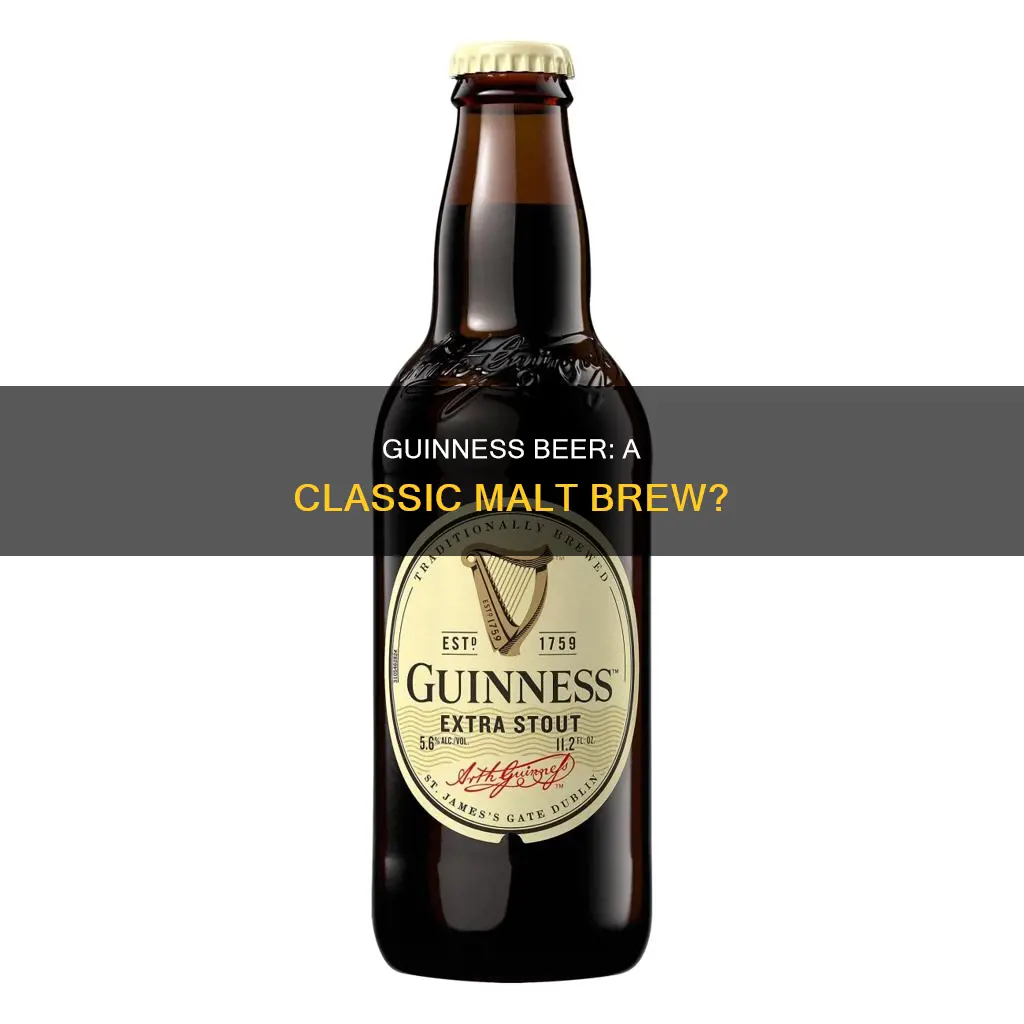
Guinness is a popular Irish dry stout with a distinctive taste and a creamy head. It was first brewed in 1759 at St. James's Gate in Dublin, Ireland, by Arthur Guinness. The beer's flavour is derived from malted barley and roasted barley, with other ingredients including hops, yeast, and water. The roasted barley gives Guinness its characteristic dark colour and unique taste, and the malted barley contributes to the beer's distinctive flavour. Guinness has a long history and is now available in over 120 countries, making it one of the most successful alcohol brands worldwide.
What You'll Learn

Guinness is a stout beer, a type of ale
The dark colour of Guinness comes from roasted barley, which also gives the beer its unique taste. The beer is pasteurised and filtered. In addition to barley, the other key ingredients in Guinness are hops, yeast, and water.
Guinness is known for its creamy head, which is created by mixing the beer with nitrogen and carbon dioxide. The nitrogen is responsible for the fine bubbles and creamy texture. The two-part pour is also an important part of the Guinness experience, with the beer being poured at a 45-degree angle into a clean, dry glass.
Guinness has a long history of marketing campaigns, from television advertisements to beer mats and posters. The brand is famous for its iconic logo, a harp that has become a symbol of Ireland. Guinness has become one of the most successful alcohol brands worldwide, brewed in almost 50 countries and available in over 120.
Guinness Beer: A Source of Vitamins?
You may want to see also

It is made with malted barley, roasted barley, hops, yeast and water
Guinness is made with malted barley, roasted barley, hops, yeast, and water. The brewing process begins with mashing, where milled barley is combined with hot water to form a mash. The mix is then boiled with hops in a process called lautering. The resulting liquid, called 'wort', is then cooled and transferred to fermentation vessels.
Malted barley is a key ingredient in Guinness, contributing to its distinctive flavour. The barley is malted, or germinated, to convert its starches into sugars, which are then fermented into alcohol. This process gives Guinness its unique taste and characteristics.
Roasted barley is another essential component of Guinness, responsible for its characteristic dark colour and unique taste. When barley grains are roasted, they develop a deep, dark hue that is transferred to the beer during brewing. This roasting process also gives Guinness its intense burnt flavour.
Hops are added to the mix to provide bitterness, balancing the sweetness of the malt. They also act as a natural preservative, helping to extend the shelf life of the beer.
Yeast is vital for fermentation, converting the sugars from the barley into alcohol. This process transforms the wort into beer.
Lastly, water is sourced for its purity and is essential to the brewing process. The water used in Guinness's brewing process comes from the Wicklow mountains, ensuring the highest quality.
The combination of these ingredients and the careful brewing process gives Guinness its iconic flavour, colour, and creamy mouthfeel.
Guinness and Breastfeeding: To Pump or Not?
You may want to see also

It is not the highest in calories compared to other beers
Guinness is a malt beer, with malted barley listed among its ingredients. In addition to malted barley, Guinness also contains hops, yeast, and water. The barley used in the brewing process is both malted and roasted, contributing to the beer's characteristic dark colour and unique taste.
While Guinness is associated with a creamy texture and rich flavour, it is not the highest in calories compared to other beers. A 12-ounce serving of Guinness Draught contains approximately 125 calories, which is relatively low compared to some other popular beers. For example, Budweiser has 145 calories, Heineken has 142 calories, and Samuel Adams Cream Stout has 189 calories in a 12-ounce serving.
The reason Guinness is not as high in calories as some other beers is due to its lower alcohol content. Guinness Draught has an alcohol by volume (ABV) of 4.2%, while Budweiser and Heineken have an ABV of 5%, and Samuel Adams Cream Stout has an ABV of 4.9%. Since alcohol is the main source of calories in beer, the lower alcohol content of Guinness contributes to its lower calorie count.
In terms of calories, Guinness is also lower or comparable to some light beers. For example, Bud Light has 110 calories and Miller Lite has 96 calories per serving, while Guinness Draught has 125 calories in a 12-ounce bottle. This makes Guinness a surprisingly calorie-conscious choice for beer drinkers.
While Guinness may be lower in calories than some other beers, it is important to remember that excessive alcohol consumption can still contribute to weight gain and other health issues. However, moderate alcohol consumption may offer some health benefits, such as a potential reduction in the risk of heart disease.
The Birth of Guinness: A Historical Perspective
You may want to see also

Guinness has a lower alcohol content than some other beers
Guinness is a malt beer, with malted barley being one of its key ingredients. The beer also contains roasted barley, hops, yeast, and water.
In comparison to other beers, Guinness Draught has a lower alcohol content. For instance, Budweiser and Heineken have an alcohol content of 5%, while Samuel Adams Cream Stout has an alcohol content of 4.9%. This lower alcohol content contributes to the perception that Guinness is a "meal in a glass", as it has a rich flavour and creamy consistency despite its relatively lower calorie and alcohol content.
The alcohol content of Guinness has changed over time, with the company introducing new variants and making adjustments to distribution and bottling. For example, the Import Stout was replaced by the Extra Stout due to consumer complaints and changes in the North American market. Additionally, Guinness has introduced non-alcoholic options, such as Guinness 0.0, which offer the same smooth taste and unique dark colour without the alcohol.
The alcohol content of Guinness also varies depending on the region where it is sold. For instance, the Foreign Extra Stout, which is sold in various regions, has an alcohol content of 5% in China, 6.5% in Jamaica and East Africa, 6.8% in Malaysia, 7.5% in the United States, and 8% in Singapore. These variations in alcohol content are due to differences in local ingredients and fermentation processes.
Guinness Beer: High-Fructose Corn Syrup Content Explored
You may want to see also

It is available in over 120 countries
Guinness is a stout that originated in the brewery of Arthur Guinness at St. James's Gate, Dublin, Ireland, in the 18th century. It is now owned by the British-based multinational alcoholic beverage maker Diageo. It is one of the most successful alcohol brands worldwide, brewed in almost 50 countries and available in over 120.
The company moved its headquarters to London at the beginning of the Anglo-Irish trade war in 1932. In 1997, Guinness plc merged with Grand Metropolitan to form the multinational alcoholic-drinks producer Diageo plc, based in London.
The original Guinness brewery is at St. James's Gate in Dublin, Ireland. While there are other brewing locations internationally, St. James's Gate remains the brand's heart and soul and is a popular tourist destination. The Guinness Storehouse, a seven-storey tribute to the black stuff, has been a tourist attraction since 2000, receiving over 20 million visitors.
Guinness is available in a number of variants and strengths, including draught, extra cold, foreign extra stout, special export stout, bitter, extra smooth, zero ABV, mid-strength, red, and 250 anniversary stout.
The United Kingdom is the largest consumer of Guinness, followed by Nigeria, then Ireland. Guinness has a significant share of the African beer market, where it has been sold since 1827. About 40% of worldwide total Guinness volume is brewed and sold in Africa, with Foreign Extra Stout being the most popular variant. Three of the five Guinness-owned breweries worldwide are located in Africa.
Guinness Beer's Carb Content: A Detailed Breakdown
You may want to see also
Frequently asked questions
The key ingredients in Guinness are water, barley (both malted and roasted), hops, and yeast.
Guinness contains antioxidants, B vitamins, silicon, soluble fibre, and prebiotics. It also has a fair amount of folate compared to other imported beers.
Yes, Guinness is a malt beer. It is made from malted barley and roasted unmalted barley, contributing to its characteristic dark colour, unique taste, and health benefits.







